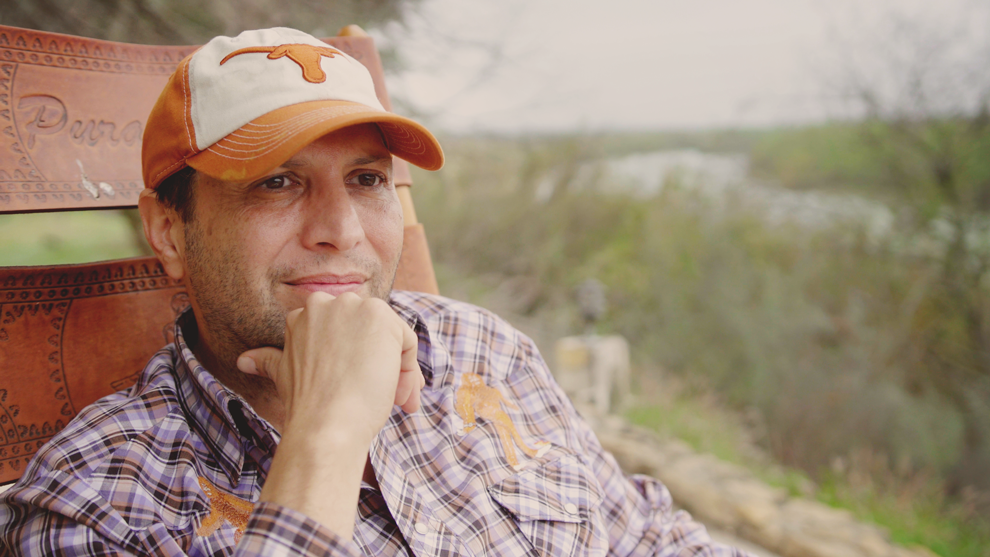It was two weeks into Donald Trump’s “national emergency,” and Poncho Nevárez was on high alert. As Nevárez trod a path toward the Rio Grande on a Saturday morning in March, his cowboy boots swishing through the wet grass, the 46-year-old Democratic state representative from Eagle Pass, Texas, was in the middle of explaining, again, why building a wall through his backyard was a solution to a problem that doesn’t exist. Just then, Lola, his deaf bluetick coonhound, began to yelp.
Nevárez scanned the thicket. Suddenly he saw them, running along the inside of the fence. He swiveled around to warn his eight-year-old son, trailing 20 yards behind.
“Ponchito, watch out!”
Danger raced past, only a few feet away—a pair of feral hogs. “I hate to shoot a piglet,” he said. “But what are you gonna do? They grow up to be sows.”
There are 7,383 state legislators in the United States, and many of them, it seems, want to do something about the border. Legislators in West Virginia and Montana have proposed using state money to help fund the wall. A lawmaker in Arizona has suggested taxing porn to pay for it. Texas Republicans wonder why the state doesn’t just build the thing itself. But in a country paralyzed by the politics of the border, Nevárez is the only state lawmaker who actually lives on it. (Nearly two dozen other lawmakers live in communities that are on the border, such as El Paso.) His ranch—where he lives with his wife, Rossy; their three kids; and a menagerie of sheep, horses, dogs, cows, and exotic birds and deer (plus the hogs)— abuts the US-Mexico border on the edge of Eagle Pass. He can’t just see Mexico from his house; when the breeze is right, he hits golf balls there.
That makes Nevárez, a trial lawyer and sometimes songwriter with family on both sides of the line, a unique voice in the debate over border security. As chair of the Texas House committee on homeland security and public safety, he wields real power (for a Democrat) in a public policy fight that has consumed his state. But unlike his colleagues, Nevárez takes his work home with him. Border Patrol sensors are scattered across his property. Fan boats pass by his patio. Trump-loving vigilantes roll up unannounced. In February, the Army arrived and set up an observation post on his ranch.
“They are willing to sacrifice a place like mine for their peace of mind, or whatever is going to make them feel good,” he said of the wall’s biggest boosters. “[It’s] this all-day sucker that they’re going to have for a while until it runs out, and then the next thing comes. And you know, I think that’s bullshit.”
Getting the border right, in his view, starts with listening to the people who live there. And Nevárez has a lot to say.
Listen to Tim Murphy interview Poncho Nevárez, the Democratic state representative from Eagle Pass, Texas, on the latest episode of the Mother Jones Podcast:
The stretch of the border Nevárez represents spans 800 miles, from east of Eagle Pass to the El Paso County line. Much of that region is impenetrable by foot, but in Eagle Pass, the desert scrub gives way to palm fronds and the boundary becomes the Border of Trumpian Imagination—relatively accessible to migrants and traffickers, close to major transportation corridors, and awash in state and federal personnel. For a time in the early 2000s, it was one of the busiest illegal entry points in the country; the Bush administration responded by installing (over local protests) a tall slatted fence through downtown, separating Mexico—and a municipal golf course—from the rest of Texas.
The sector has calmed some, but when I visited Nevárez in early March, the city was reeling from its most recent turn in the spotlight. A few weeks earlier, 1,600 asylum seekers had arrived across the Rio Grande in the Mexican city of Piedras Negras, where, for lack of shelter, they were locked in an old factory by Mexican authorities. The Pentagon dispatched 250 troops to Eagle Pass in response; nine days later, Trump declared the border a “national emergency.”
The road into town was crawling with military vehicles, but Nevárez’s ranch, which begins about two miles upriver from where the fence ends, was an oasis of quiet, punctuated only by the ambient screeching of peacocks and macaws. Just past the driveway, the lawn ended abruptly at a cliff. A duck flew low along the water, straddling the international boundary with its wings.
Nevárez fired up an ATV for a quick tour, winding up a dirt road to an overlook that offered clear sightlines for miles. Under a ramada near the ledge, a pair of Army grunts in fatigues sat looking bored in a Ford F-250—the only visible indicator of the emergency in our midst. Nevárez borrowed a pair of binoculars from one of them to look for his goats and pointed out a Border Patrol observation tower near the edge of his property.
Though he considers Trump’s troop surge unnecessary, Nevárez doesn’t have a problem with the Border Patrol. Its agents have the code to his gate, and he coordinates with them when he has hunters on the land. Rattling off the number of apprehensions along the southern border, Nevárez argues the agency has done its job well by using a mixture of analog and high-tech tools. Cliffs and fords and roads create chokepoints; sensors, cameras, and lookouts help you manage them.
“I’m not against border security,” he said. “I just think there’s a smarter way to do it.”
As he sees it, physical barriers and boots on the ground hit a point of diminishing returns, because migration patterns adapt. Build a wall the length of South Texas and the traffic will simply move west, where the crossing is more dangerous. The caravans of asylum seekers that precipitated Trump’s military response don’t necessitate such measures because they simply turn themselves in. And if the concern is drug trafficking, then ports of entry, where the overwhelming percentage of drugs slip through, are the system’s soft underbelly. According to Nevárez, only 1 in 20 vehicles get inspected at Eagle Pass. Put the ports “on steroids,” he argued (and improve the roads while you’re at it) and you’ll catch more contraband, while performing a service for the people who live along the border—a more efficient process that will make it easier for traffic to come and go, for people to get to work and see family, for commerce to connect with I-35.
Like many of his constituents, Nevárez lives a binational existence. When he’s not in Austin for work, he’s in Mexico at least several times a week, to tend to his ranch (which spans both sides of the border), take his son to football practice (the team plays in Piedras Negras), or visit relatives (both he and his wife have family in Coahuila). A holistic border policy would accept such realities as foundational. Instead, it’s built around night-vision fever dreams.

Mark Helenowski
A few weeks earlier, Nevárez was making his rounds when four men pulled up to his gate in a pickup truck. “They worked somewhere in the oil fields, and they were wearing Trump campaign shirts—blue ones that said ‘Trump-Pence,'” he said.
Nevárez asked the men what they were doing there. “We’re looking for action,” one of them replied. He told them to get lost. “I’m more afraid of that than I am the people that would come across” the border.
It was a one-time encounter that encapsulated his broader frustration with Trump’s policies—that solutions like a wall or a troop surge are foisted on the border by people who don’t live there, to appease other people who don’t live there, reducing whole communities to no man’s lands.
“We have to be vigilant about not being a punching bag,” he said. “Because we tend to be that, and we have been for a long time.”
When I returned the next morning, Nevárez wanted to show me the river, so we set off down a path that led away from his house. As we passed the pool, he pointed to the palm trees above, where a committee of vultures held court. In addition to defecating on their legs to cool off, vultures make hideous guttural sounds at night, and Nevárez deployed an air cannon to keep them away. Sometimes life on the border feels like a malicious game of telephone, where track jackets become prayer rugs and prayer rugs become ISIS, and suddenly Don Jr. is tweeting about it. And so it was, in a way, with the vultures.
“When all this shit started in Mexico, we had the cannon going,” Nevárez said. “There were these reports of cannon fire and all this stuff—that military was setting off a cannon because of whatever was going on with the caravan that was in Piedras Negras. But it wasn’t. It was us. We were shooting the cannon.”
About 100 yards past the house, we came to an opening where the brush had been cleared away, and the path slouched gently toward Mexico, forming a makeshift boat launch, sometimes used by the Border Patrol, that its proprietor calls Nevárez Beach. When migrants do cross at his ranch, it’s often here, guided through the darkness by the illuminated stained-glass window in Nevárez’s study.
As we got closer, we spotted evidence of recent visitors—socks, a trash bag, some water bottles.
“They probably came up through here and then jumped that fence, and they have a pretty good idea where the highway is,” he said, surveying the scene. “Probably two women, it looks like from the clothes.”
This was the kind of tableau that wall advocates seize on—proof, they argue, that the border is overrun, that new measures must be taken to keep the invaders away. But Nevárez just shrugged.
“I go to sleep here every night, my wife and my kids sleep here every night, and we’ve never had so much as a bolt stolen out of the bodega, or a chainsaw or whatever,” he said. “People say, ‘Well, maybe you’re safe but we’re not safe from the onslaught.’ But what onslaught are we talking about?”
Trump’s much-hyped invasion is a bump in the night that loses its capacity to spook when it comes into the light. After they’re processed by Border Patrol, asylum seekers get dropped off at a church where Nevárez’s mother, a retired secretary, offers them clothes and blankets, a chance to use the phone, and sometimes cash. Nevárez keeps bottles of water in his truck for migrants he sees. A few Decembers back, he found two Cubans, wet and shivering, by the entrance to his ranch. He gave them a lift to a Border Patrol truck down the road.
Thanks to Cold War politics, Cubans get a fresh start and a path to citizenship, and Mexicans who come across the same way “get a boot in the ass,” he said. “And while I sympathize with Cubans that are coming, that’s a remnant of the political reality that doesn’t really exist anymore.” The inflexibility of immigration and border policies in response to changing realities frustrates Nevárez, and it’s part of why he’s so adamant about putting the brakes on Trump’s escalating militarization of the border: It is the nature of these things that they are hard to undo. The policy you implement to address one crisis, real or imagined, will be a part of the landscape long after the situation has changed. Walls go up; they rarely come down.
Later that weekend, Nevárez was supposed to host a Republican colleague who was passing through town. “I said, ‘Why don’t you come out to the house, we’ll grab some lunch, and I’ll take you by the ranch and maybe you’ll shoot something. You can get an idea of what a national emergency looks like,'” Nevárez said. He extends such invitations freely to colleagues, the media, a right-wing radio host. Last year, he brought Beto O’Rourke and the brothers Joaquin and Julián Castro to his home for a Facebook Live.
The idea that the real border threats are rattlesnakes and feral hogs hasn’t quite taken hold in the GOP. But even as Washington goes further around the bend, there are tentative signs that the fever is starting to break in Texas. Nevárez’s appointment in January to chair the homeland security and public safety committee in a Republican-run chamber was a nod to bipartisanship and a changing political climate. In 2017, a decade of conservative dominance in the capitol, which included the deployment of state police and Texas National Guard units to the border in 2014 (they’re still there), culminated in the passage of SB 4, the state’s criminalization of sanctuary cities. On the final day of the session, a Republican state representative, Matt Rinaldi, bragged about calling Immigration and Customs Enforcement on a group of protestors who opposed the law, leading to a scuffle on the floor between he and Nevárez. Last fall, Democrats picked up 12 seats in the state House—including Rinaldi’s.

Mark Helenowski
Texas’ border counties notoriously have some of the worst voter participation in one of the nation’s lowest-turnout states. But in an election that Republicans turned into a referendum on the border, Democratic turnout surged across the state and up and down the Rio Grande. In Maverick County, which includes Eagle Pass, turnout nearly doubled compared to 2014.
“I can’t believe that this didn’t play some part in what happened in the [midterms],” Nevárez said of the wall. “It did especially here in Texas. It will continue to do that the more this thing is going to drag out, as long as this guy is a president, and beyond.”
Mexico isn’t the only thing Nevárez can see from his home, by a river his family has lived along for generations. He can also glimpse a gaping hole in the rhetoric about what to do with his backyard. The demographic change that immigration restrictionists fear, and that their policies are focused on stopping, isn’t something new. What they’re afraid of is what places like Eagle Pass have always been. And Nevárez likes his hometown just fine. “The truth is, the change is already here,” Nevárez said. “It’s not what’s coming across the river—it’s us. We’re here, and we’re not going anywhere, and we will change it, and that’s the fear. It’s code-speak, like ‘You’re changing my United States or Texas’ or whatever—it’s my Texas too, bud. It always was.”
We sat down in rocking chairs by the river and he flipped through his phone to show off a shaky video he’d grabbed of a bobcat. A Border Patrol boat whirred by.
“The Spaniards would call this terra incognita, and I guess they recognized that it was some sort of barrier because they had a hard time crossing it,” he said. “Maybe in a thousand years there’s not going to be a US, or Mexico, or a Texas, or a Coahuila. It will just be like some sort of frontier the way it was then.”
“None of this shit will matter,” he said. “But for now, it’s everything.”












